Victor Alexandrovitch Hartmann was born April 23rd, 1834, in St. Petersburg. Both his parents died before he was four years old, and he was brought up by an aunt, Luisa Ivanovna Gemilian, wife of a well-known St. Petersburg architect and a former lady-in-waiting to the tsarina. Through the influence of Mme. Gemilian, Hartmann was admitted at the age of twelve to the Imperial Academy of Mines, where he distinguished himself mainly by drawing sharp, malicious caricatures of his teachers. After six years he was withdrawn from the Mining Academy and placed in the Academy of Fine Arts. Here his progress was extremely rapid, both in painting and architecture. In 1862 he left the Academy, having won its highest awards, and embarked upon his professional career. In 1864 Hartmann married and went abroad. Most of his watercolors and genre sketches date from this period, including six of the ten pictures immortalized by Mussorgsky. Three of his four years abroad were spent in France, especially in Paris, Limoges, and Perigueux, but he also visited Italy, Germany, and Poland. He painted and photographed innumerable cathedrals and other masterpieces of architecture.
Hartmann was what the Russian critics called “a man of the 6o’s”. The phrase refers to the period in the 19th century in which Russian artists in every medium sought to create a distinctively Slavic renaissance in peasant handicraft, folk-song, folk-tales, the daily life of the contemporary world, and the traditions of medieval Russia. This movement produced the Mily Balakirev circle through which, in 1870, Hartman would meet Vladimir Stassov, Director of Fine Arts at the Imperial Library. Through this group of artists, Hartmann would also become a close friend of the composer, Modest Mussorgsky.
Following Hartmann’s early death from an aneurysm at the age of only 39, an exhibition of over 400 of his paintings was displayed in the Academy of Fine Arts in Saint Petersburg, in February and March 1874. The Hartmann Memorial Exhibition of 1874 was largely the result of Vladimir Stassov’s single-handed enthusiasm, although Stassov was assisted by Count Paul Suzor, president of the St. Petersburg Architectural Association. Many pictures in the exhibition were lent by private owners, and these were presumably returned when it closed. Many others were sold at the exhibition itself, and little is known about their current locations. After Hartmann’s death, the artistic world gradually lost interest in him and little of his work has been exhibited since 1874, except a few pictures said to have been shown at the Leningrad Public Library in connection with the observance of the fiftieth anniversary of Mussorgsky’s death, in 1931. Interest in Mussorgsky’s Pictures at an Exhibition, which might have helped to preserve Hartmann’s works, did not spread until many years too late. The music was not published until 1886 and did not attain its present widespread popularity until it was orchestrated by Ravel in 1922. Consequently, of the four hundred Hartmann works displayed before Mussorgsky’s gaze in 1874, not more than sixty-five can be found today.
Of the ten works that inspired Modest Mussorgksy’s ten-movement work, images of four have been lost over time. Below are images and information about the six remaining pieces.
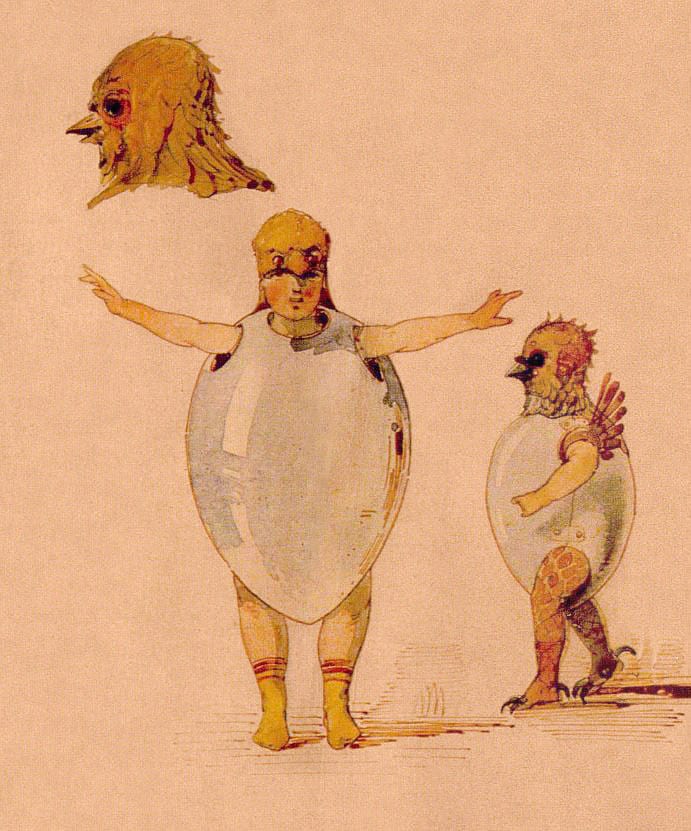
Victor Hartmann
Chicks in Shell
Watercolor
Hartmann drew 17 costume and set designs for the ballet Trilbi, four of which are extant. This is the sketch that inspired Mussorgsky’s Ballet of the Unhatched Chicks. Trilbi was first performed at the Bolshoi Theater in Moscow in 1871, with choreography by Marius Petipa and music by Julius Gerber. The plot was loosely based on a short story by the French author Charles Nodier titled “Trilbi, or the Elf of the Argyle“, published in 1822. Petipa moved the setting from Scotland to Switzerland and made other substantive changes as well. The title was changed to “Trilbi, the Demon of the Hearth”. The ballet featured children from the Russian Imperial Ballet School dressed variously as birds, butterflies and, as in this sketch, chicks still in their eggs. In this image performers are dresses as canary chicks, enclosed in eggs as in suits of armor. Instead of a head-dress, they wear canary heads, put on like helmets, down to the neck.
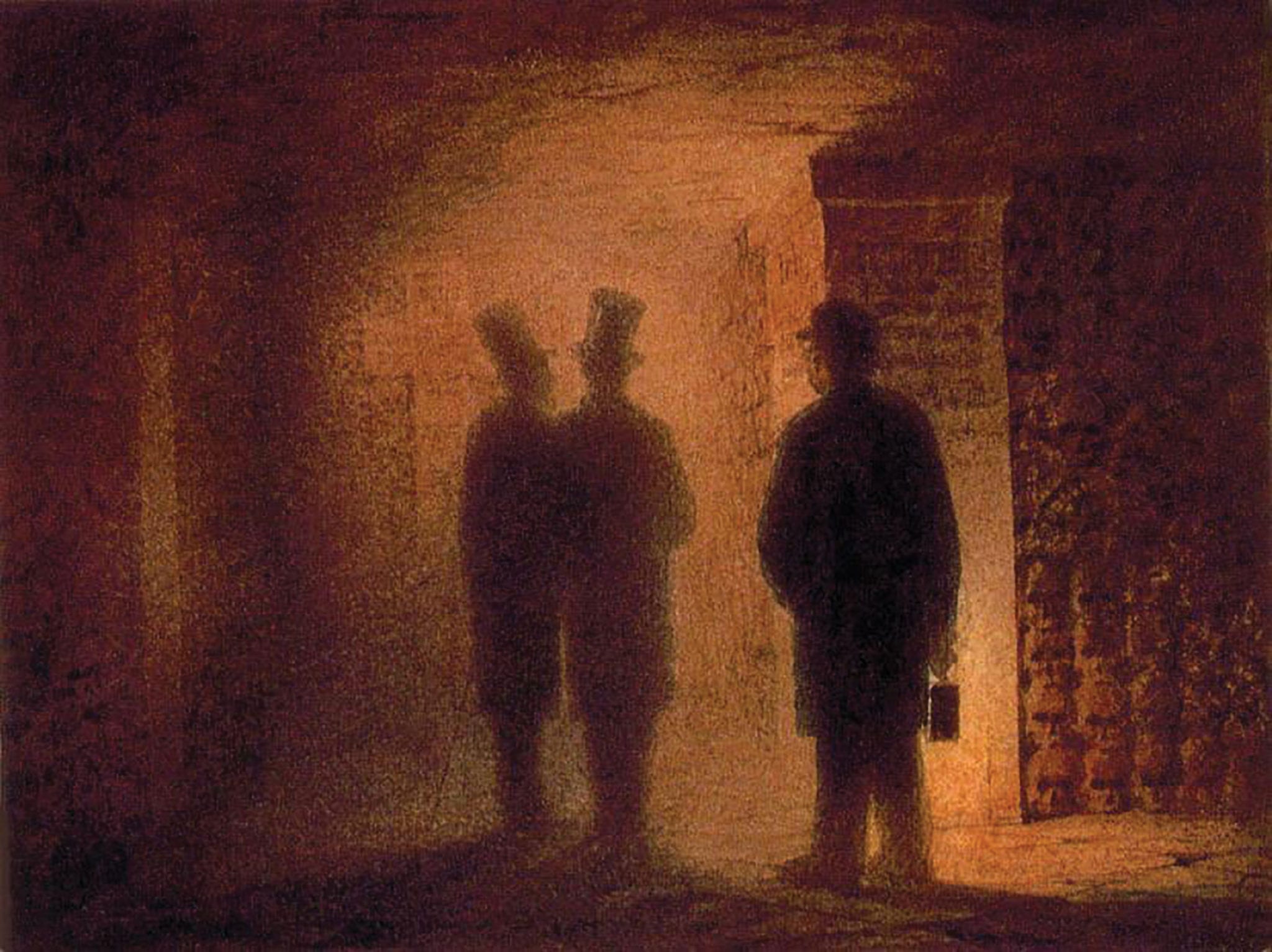
Victor Hartmann
Catacombs
Hartmann had graduated from the Academy of Fine Arts with honors and was thus allowed four years abroad at government expense as a sort of post-graduate education. Hartmann spent three of those years in France, and here made the drawings and paintings that were to become the inspiration for three of Mussorgsky’s musical sketches: Tuileries, Limoges, and The Catacombs, represented here. This is a self-portrait of the author in the Roman catacombs beneath the streets of Paris. The exhibition catalogue from 1874 describes the image as: “Interior of Paris catacombs with figures of Hartmann, the architect Kenel, and the guide holding a lamp.”
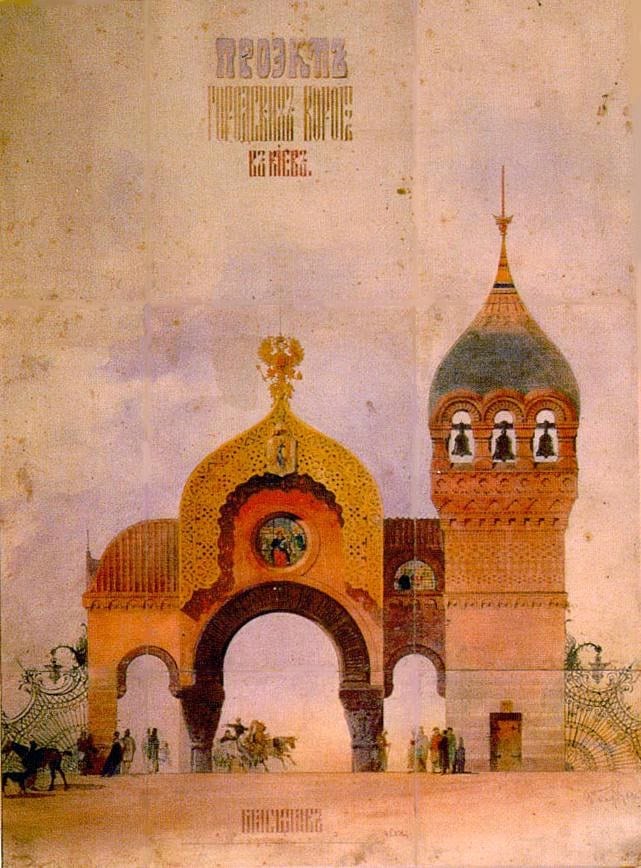
Victor Hartmann
The Great Gate of Kiev
Watercolor
In 1869 Hartmann entered a competition for a gateway to be erected at Kiev in commemoration of what Russian writers of the period, working under the watchful eye of the Imperial censor, refer to circumspectly as “the event of April 4, 1866”. The date on which the Emperor Alexander II escaped assassination at Kiev. Hartmann’s drawing represented his project for a gate in the city of Kiev in the massive, old Russian style. The archway rests on granite pillars, three quarters sunk in the ground. Its head is decorated with a huge headpiece of Russian carved designs, with the Russian state eagle above the peak. To the right is a belfry in three stories with a cupola in the shape of a Slav helmet. Hartmann’s design for the Great Gate of Kiev caused a sensation and he himself regarded it as his finest work. It has been reproduced more often than any of his designs and it inspired Mussorgsky to write one of his most magnificent pages. But, the competition was called off and Hartmann’s Kiev gate was never erected.
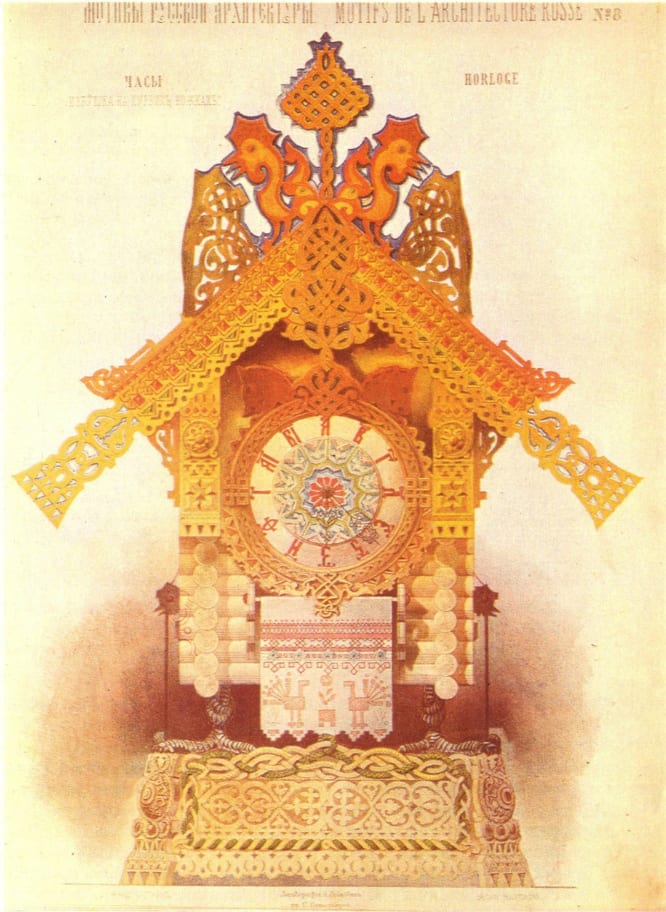
Victor Hartmann
The Hut on Fowl’s Legs
Watercolor
Hartmann’s drawing represents a clock in the form of Baba Yaga’s hut. As a sinister, supernatural figure within Eastern European folklore, Baba Yaga is typically depicted as an old woman flying in a mortar, wielding a pestle, and living deep in the forest in a home that travels on chicken’s legs. This clock, in the Russian style of the 14th century, features carved gables, cock motifs, and elaborate ornamentation after textile and rope patterns. These designs are all highly typical of Hartmann’s architectural style.
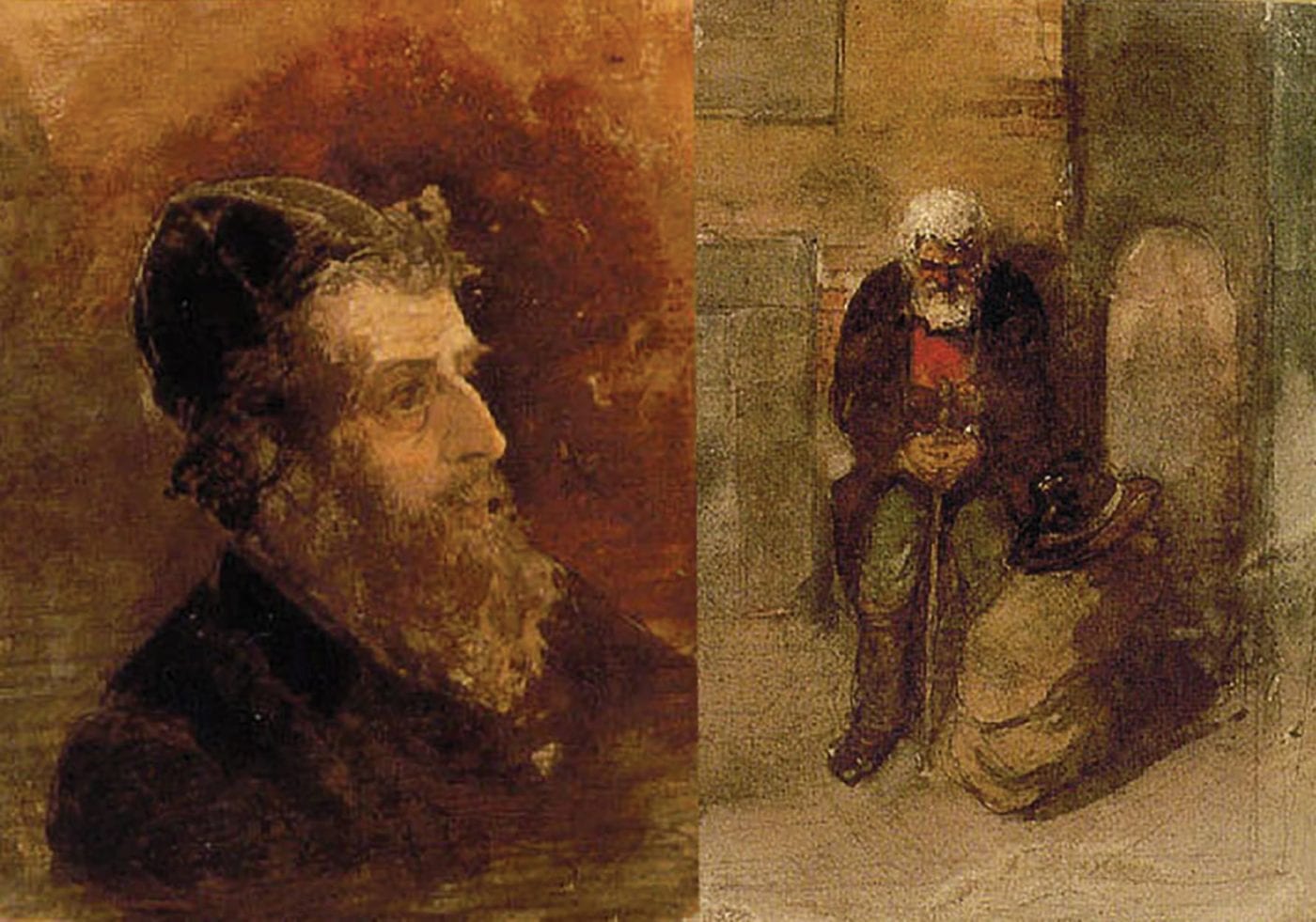
Victor Hartmann
Two Polish Jews
Watercolor
Hartmann spent a month in Poland sketching and painting, especially around the town of Sandomir. Mussorgsky’s inspiration is likely the two pencil drawings listed in the 1874 catalogue as Nos. 176 and 177. The first is described as “A rich Jew wearing a fur hat: Sandomir”, and the second as “A poor Sandomir Jew”. Both, according to the catalogue, were the property of Mussorgsky himself, and they are the only pictures the ownership of which is ascribed to him. This was the one movement in the suite that the composer did not title, and for a time it was known merely as “two Polish Jews”. Hartmann apparently had made another drawing titled Samuel Goldenburg and Schmuyle, the location of which is unknown. It is speculated that the composer’s friend and patron, Vladimir Stassov, had mistaken this drawing as the inspiration for the movement, and applied the name to it after Mussorgsky’s death in 1881.
Written by Matthew Patterson, Assistant Director of Community and Public Programs at MOCA Jacksonville.
The Jacksonville Symphony has partnered with MOCA Jacksonville and the Cummer Museum of Arts & Gardens for a discussion centering on the artwork of artist Victor Hartmann that serves as the inspiration for Modest Mussorgsky’s ten-movement work, Pictures at an Exhibition. Lindsay Bowyer of MOCA Jacksonville and Holly Keris of The Cummer Museum of Art & Gardens will join Associate Conductor Nathan Aspinall for Insight, the Symphony’s pre-concert talk in Jacoby Symphony Hall, to discuss the “pictures at an exhibition” by artist Victor Hartmann that inspired Mussorgsky’s ten-movement work. Join us for Insight in Jacoby Symphony Hall at 7 PM, Friday and Saturday, NOV 9/10.


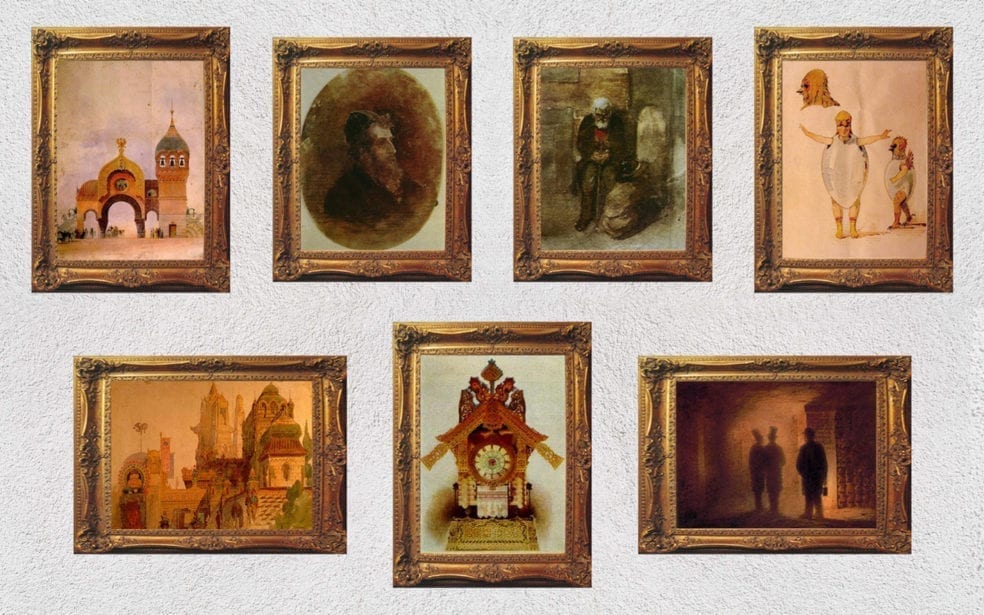
One Comment on “Pictures at an Exhibition: About Victor Hartmann”
Pingback: 100 Years of Mussorgsky/Ravel's 'Pictures': Exhibition is Still Open | Arts – Harvard Crimson – Daily Research